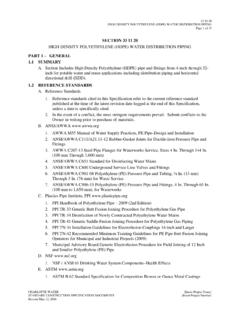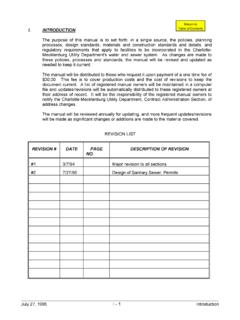Transcription of CHAPTER 4 STORM DRAINAGE SYSTEMS - Charlotte, North …
1 CHARLOTTE-MECKLENBURG STORM water DESIGN MANUAL CHAPTER 4 STORM DRAINAGE SYSTEMS Overview .. 4-1 Introduction .. 4-1 Inlet Definition .. 4-1 Criteria .. 4-1 Pavement DRAINAGE .. 4-2 Introduction .. 4-2 STORM Drain Location .. 4-2 Inlet Types and Spacing .. 4-2 Longitudinal Slope .. 4-3 Cross Slope .. 4-3 Curb and Gutter .. 4-3 Median Ditches .. 4-3 Roadside 4-3 Bridge Decks .. 4-3 Median Barriers .. 4-4 CHARLOTTE-MECKLENBURG STORM water DESIGN MANUAL Gutter Flow Calculations .. 4-4 Formula.
2 4-4 Procedure .. 4-4 Grate Inlet Design .. 4-7 Grate Inlets on Grade .. 4-7 Design Steps .. 4-7 Example 1 .. 4-9 Grate Inlets in Sag .. 4-10 Type 'E' Grate .. 4-10 Grated Drop 4-12 Example 2 .. 4-12 Open Throat Catch Basin .. 4-13 Example .. 4-13 Combination Inlets .. 4-14 Combination Inlets on Grade .. 4-14 Hydraulic Gradient .. 4-14 Friction Losses .. 4-14 Velocity Head Losses .. 4-14 Entrance Losses .. 4-14 Junction Losses .. 4-15 Summary .. 4-17 STORM Drain .. 4-20 Introduction.
3 4-20 Design Criteria .. 4-20 Capacity .. 4-20 Hydraulic Grade Lines .. 4-22 CHARLOTTE-MECKLENBURG STORM water DESIGN MANUAL Design Procedure .. 4-22 Minimum Grade .. 4-24 Design Procedures .. 4-24 Rational Method Examples .. 4-27 CHAPTER 4 STORM DRAINAGE SYSTEMS 4-1 OVERVIEW Introduction In this CHAPTER , guidelines are given for calculating gutter and inlet hydraulics and STORM DRAINAGE design. Procedures for performing gutter flow calculations are based on a modification of Manning s equation. Inlet capacity calculations for grate and combination inlets are based on information contained in HEC- 22 (USDOT, FHWA, September 2009).
4 STORM drain design is based on the use of the rational formula. Inlet Definition There are four STORM water inlet categories: curb opening inlets grated inlets combination inlets multiple inlets In addition, inlets may be classified as being on a continuous grade or in a sag. The term continuous grade refers to an inlet located on the street with a continuous slope past the inlet with water entering from one direction. The sag condition exists when the inlet is located at a low point and water enters from both directions.
5 Criteria The following criteria shall be used for DRAINAGE system design. Maximum spread of 6 feet in a travel lane based on a rainfall intensity of 4 inches/hour. For a street with a valley gutter, another foot for the gutter is allowed with a total maximum spread of 7 feet based on a rainfall intensity of 4 inches per hour. For a street with a standard 2 feet 6 inch curb and gutter, an additional 2 feet is allowed with a total maximum spread of 8 feet from the face of the curb based on a rainfall intensity of 4 inches per hour.
6 See Section for additional criteria on design STORM frequencies. Other In sag areas where relief by curb overflow is not provided the system standard design level (Q25 Q50) is to be used for analysis to ensure traffic flow is not interrupted (NC Division of Highways, Guidelines for DRAINAGE Studies and Hydraulic Design, 1999). Therefore, in a sag condition where relief by overflow for a typical roadway cross section is not provided, inlet capacity and the STORM DRAINAGE system must be designed for: o one dry 8 foot travel lane in the 25-year event for local streets; and o one dry 8 foot travel lane in each direction in the 50-year event for thoroughfares.
7 All upstream bypass flow must be considered in the design of the inlets and the STORM DRAINAGE system at the sag. Available overflow at sag locations can be considered when making the determination for available travel lanes in the relevant STORM events. CHARLOTTE-MECKLENBURG STORM water DESIGN MANUAL 4-2 For local roads the pipe system hydraulic grade line shall not surcharge sag inlets in the 25-year STORM . For thoroughfare roads the pipe system hydraulic grade line shall not surcharge in the 50-year STORM . When checking spread requirements at sag points (0% slope) check spread upstream of sags (at the slope point) to verify spread is not exceeded.
8 Additional flanking inlets upstream may need to be added to keep spread criteria from being exceeded at these points. Ponding at yard inlets outside the roadway shall be limited to a maximum of one foot above a grated inlet for the 10-year STORM . No concentrated runoff flowing over City sidewalks except at driveways. Roadside ditches, when allowed, shall be a minimum of 18 inches deep and shall provide the capacity designed for a 10-year STORM with 6-inches of freeboard. For subdivision streets ditch flow for the 25-year STORM shall not encroach onto the pavement.
9 For thoroughfare streets ditch flow for the 50-year STORM shall not encroach onto the pavement. For subdivision streets the driveway and culvert shall be designed such that the flow from a 25-year STORM shall not encroach onto the roadway pavement. For thoroughfare streets the driveway and culvert shall be designed such that the flow from a 50-year STORM shall not encroach onto the roadway pavement. 4. 2 PAVEMENT DRAINAGE Introduction Design factors to be considered during gutter, inlet and pavement DRAINAGE calculations include: Return period Cross slope Spread Curb and gutter sections STORM drain location Roadside and median ditches Inlet types and spacing Bridge decks Longitudinal slope Median barriers Shoulder gutter STORM Drain Location For standards related to STORM drain location refer to the Charlotte Land Development Standards Manual.
10 Inlet Types and Spacing Inlet types shall be selected from the Charlotte Land Development Standards Manual or equivalent North Carolina State Department of Transportation standards. Inlets shall be located or spaced in such a manner that the design curb flow does not exceed the spread limitations. Flow across intersecting streets will be reviewed and approved on a case by case basis. CHAPTER 4 STORM DRAINAGE SYSTEMS 4-3 Longitudinal Slope A minimum longitudinal gradient is more important for a curbed pavement, since it is susceptible to stormwater spread.










